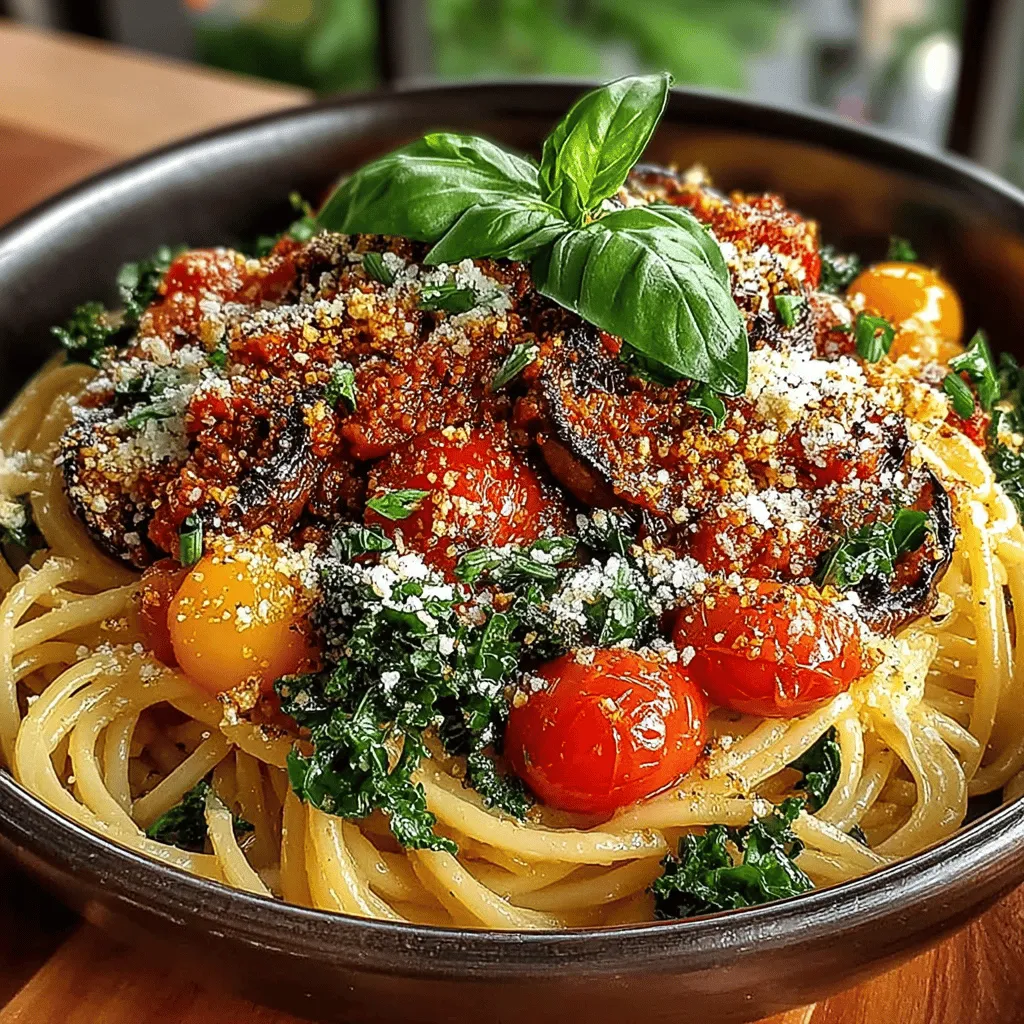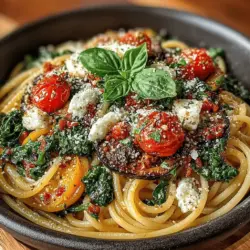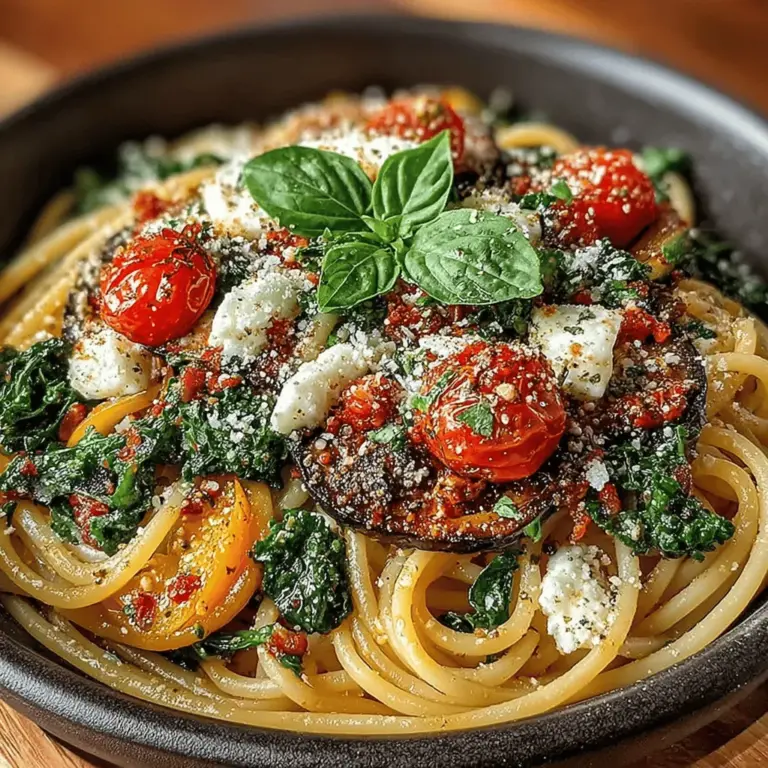Eggplant & Kale Garden Pasta: A Wholesome Dish for Every Palate
In recent years, the shift towards plant-based meals has not only gained traction but has also become a lifestyle choice for many, driven by a growing awareness of health benefits and environmental sustainability. Among the plethora of vegetarian recipes that have emerged, Eggplant & Kale Garden Pasta stands out as a vibrant and nourishing option. This delightful dish features wholesome ingredients such as whole grain pasta, nutrient-dense kale, and flavorful eggplant, making it an excellent choice for a satisfying weeknight dinner or a casual gathering with friends.
Eggplant & Kale Garden Pasta is more than just a meal; it’s a celebration of fresh produce and the art of cooking with seasonal ingredients. The combination of textures and flavors creates a dish that is not only delicious but also visually appealing, making it a perfect centerpiece for any dining table. In this article, we will delve into the preparation of this scrumptious recipe, highlighting the nutritional benefits of each ingredient and discussing the culinary techniques that enhance its appeal.
Understanding the Ingredients
Whole Grain Pasta: A Healthier Choice
When it comes to selecting pasta, choosing whole grain over refined varieties offers significant health advantages. Whole grain pasta is made from the entire grain, preserving the bran, germ, and endosperm, which contributes to its higher fiber content. This fiber is crucial for digestive health, helping to maintain regularity and prevent constipation. Additionally, whole grain pasta is linked to improved heart health, as it can help lower cholesterol levels and reduce the risk of heart disease.
The nutty flavor and hearty texture of whole grain pasta also complement the robust ingredients in Eggplant & Kale Garden Pasta. By opting for this healthier choice, you enhance not only the nutritional profile of your meal but also its overall flavor.
The Star Vegetable: Eggplant
Eggplant, often referred to as aubergine, is a versatile vegetable that brings a unique texture and rich flavor profile to dishes. Its nutritional profile is impressive; eggplant is low in calories but high in fiber, making it an excellent addition to any weight-loss or health-conscious diet. It is also a source of antioxidants, particularly nasunin, which is found in the skin and is known for its protective properties against cellular damage.
In the context of Eggplant & Kale Garden Pasta, the eggplant’s creamy texture when cooked creates a satisfying contrast against the chewy whole grain pasta. Its ability to absorb flavors makes it an ideal ingredient for this dish, as it soaks up the savory elements of the sauce.
Kale: The Superfood
Kale has earned its reputation as a superfood for good reason. Packed with vitamins A, C, and K, along with essential minerals like calcium and potassium, kale is a powerhouse of nutrition. The high antioxidant content in kale helps combat oxidative stress and inflammation, supporting overall health and wellness.
When preparing Eggplant & Kale Garden Pasta, it is essential to select fresh, vibrant kale. Look for leaves that are deep green and free from yellowing or wilting. To prepare kale for cooking, simply remove the tough stems and chop the leaves into bite-sized pieces. This nutrient-rich green not only adds color to the dish but also contributes a satisfying crunch, balancing out the softness of the eggplant and pasta.
Aromatics: Garlic and Onion
No pasta dish is complete without the foundational flavors provided by aromatics such as garlic and onion. These ingredients are pivotal in developing the overall flavor profile of Eggplant & Kale Garden Pasta. Garlic is known for its robust taste and numerous health benefits, including its potential to boost the immune system and lower blood pressure. Onions, on the other hand, add sweetness and depth to the dish, enhancing the other flavors.
The combination of sautéed garlic and onion creates a fragrant base that sets the stage for the other ingredients, ensuring that each bite is filled with flavor.
Tomatoes: A Flavorful Base
Canned tomatoes are a staple in many Italian pasta dishes, and for good reason. They provide a rich, tangy base that complements the earthiness of the eggplant and the bitterness of the kale. The natural sweetness of tomatoes balances the savory elements of the dish, resulting in a harmonious flavor profile.
In addition to their culinary contributions, tomatoes are a great source of vitamins C and K, potassium, and folate. They are also rich in lycopene, an antioxidant that has been linked to various health benefits, including heart health and reduced risk of certain cancers. For the Eggplant & Kale Garden Pasta recipe, using high-quality canned tomatoes ensures that you achieve a rich sauce that serves as the heart of the dish.
Preparing the Eggplant & Kale Garden Pasta
Cooking the Pasta to Perfection
The first step in creating Eggplant & Kale Garden Pasta is cooking the pasta to perfection. To achieve the ideal al dente texture, bring a large pot of salted water to a rolling boil. Add the whole grain pasta and cook according to the package instructions, usually around 8-10 minutes. It’s essential to taste the pasta a minute or two before the suggested cooking time to ensure it has the right texture—firm yet tender.
One crucial tip when cooking pasta is to reserve about a cup of the pasta cooking water before draining it. This starchy water will be a valuable addition to your sauce, helping to achieve the desired consistency and allowing the sauce to cling to the pasta beautifully.
Sautéing Vegetables: Building Flavor
While the pasta cooks, you can begin sautéing the vegetables to build layers of flavor in your Eggplant & Kale Garden Pasta. Start by heating a generous amount of olive oil in a large skillet over medium heat. Once the oil is shimmering, add finely chopped onion. Sauté the onion until it becomes translucent, usually about 3-5 minutes.
Next, add minced garlic to the skillet, cooking for an additional minute until fragrant. Be cautious not to burn the garlic, as it can turn bitter.
Once the aromatics are ready, it’s time to add the diced eggplant. The key to cooking eggplant is to allow it to brown and soften. Stir occasionally, letting the eggplant cook for about 5-7 minutes until it develops a golden-brown exterior and a creamy interior. This step is vital for bringing out the eggplant’s flavor and ensuring it integrates well with the other ingredients.
Creating the Sauce
With the vegetables sautéed, you can now create the sauce that brings the Eggplant & Kale Garden Pasta together. Start by adding canned tomatoes to the skillet, breaking them up with a spoon if they’re whole. Incorporate a splash of balsamic vinegar, which adds a tangy sweetness that enhances the dish’s overall flavor. Season the mixture with salt, pepper, and your choice of herbs—basil, oregano, and thyme work exceptionally well.
Allow the sauce to simmer for about 10 minutes, letting the flavors meld together. If the sauce appears too thick, gradually stir in some reserved pasta cooking water until you reach the desired consistency.
As the sauce simmers, add the chopped kale, cooking just until it wilts down. This ensures that the kale retains some of its vibrant color and nutritional benefits while still integrating into the dish.
Now that you’ve prepared a flavorful sauce, you’re just a few steps away from enjoying a hearty serving of Eggplant & Kale Garden Pasta. This dish is not only packed with nutrients but also embodies the essence of plant-based cooking, celebrating fresh ingredients and robust flavors. Stay tuned for the final steps in completing this delightful recipe.

The Significance of Adjusting Seasoning for Optimal Taste
Seasoning is a crucial element in cooking that can elevate your dish from ordinary to extraordinary. For the Eggplant & Kale Garden Pasta, adjusting the seasoning at various stages of preparation ensures that the flavors meld beautifully. Start with a base of salt and pepper, then taste as you go. Remember, the ingredients themselves—like the eggplant and kale—will bring their unique flavors, so it’s essential to balance these with your seasonings.
Incorporating Kale
When adding kale to your pasta dish, it’s vital to do so in a way that preserves its vibrant color and nutritional value.
Best Practices for Cooking Kale in the Dish
1. Choose the Right Kale: Curly kale is popular for its texture, while Lacinato (or dinosaur) kale has a slightly sweeter, more tender profile. Both work well, so pick based on your taste preference.
2. Prepping the Kale: Remove the tough stems and chop the leaves into bite-sized pieces. This will help them cook evenly.
3. Cooking Method: Add the kale to the pan with the sautéed vegetables about 2-3 minutes before you combine everything with the pasta. This allows the kale to wilt without losing its vibrant green color.
4. Cooking Time: Keep the cooking time minimal, aiming for just enough to soften the kale while retaining some crunch. Overcooking can lead to a dull color and diminished nutrients.
How to Ensure the Kale Retains Its Vibrant Color and Nutrients
To keep your kale bright and nutrient-rich, consider blanching it briefly in boiling water for 1-2 minutes before adding it to the sauté. This quick method not only enhances the color but also helps to reduce any bitterness. After blanching, plunge the kale into ice water to halt the cooking process. Drain and add it to the sautéed vegetables just before combining with the pasta.
Combining Ingredients for a Cohesive Dish
Tossing Pasta with the Sauce
Once all components are prepared, it’s time to bring them together harmoniously.
Techniques for Ensuring Even Distribution of Sauce and Vegetables
1. Use a Large Mixing Bowl: Transfer your cooked pasta to a large bowl to allow ample space for mixing.
2. Add the Sauce Gradually: Pour your sauce over the pasta in increments and toss gently. This prevents the sauce from clumping and ensures every noodle is coated.
3. Incorporate the Vegetables: Gently fold in the sautéed eggplant, kale, and any other vegetables you’ve added to the mix. Use tongs or two large spoons to lift and fold the pasta with the sauce, ensuring an even distribution.
The Importance of Adding Reserved Pasta Water for the Right Consistency
Before draining your pasta, reserve about a cup of the starchy cooking water. This water is valuable for adjusting the consistency of your sauce. When the pasta is mixed with the sauce, if it appears too thick, gradually add the reserved pasta water until you reach the desired creaminess. The starch from the water helps the sauce cling to the pasta beautifully, creating a cohesive dish.
Final Seasoning Adjustments
Before serving, it’s essential to do a final taste check.
Tips for Tasting and Adjusting Flavors Before Serving
1. Taste the Dish: Use a clean spoon to taste the pasta. Check for seasoning levels and adjust with salt, pepper, or a squeeze of lemon juice for brightness.
2. Balancing Flavors: If the dish feels flat, a splash of balsamic vinegar or a sprinkle of red pepper flakes can enhance its depth. Remember that acid can elevate flavors—don’t be afraid to experiment to find the right balance.
3. Warmth and Acidity: If you find the dish too acidic, a pinch of sugar can help balance it. Conversely, if it lacks brightness, add more citrus or vinegar.
Serving Suggestions
Garnishing Your Dish
Presentation plays a vital role in the dining experience.
The Role of Fresh Basil in Enhancing Flavor and Presentation
Fresh basil leaves add a pop of color and a fresh flavor to your pasta. After plating, sprinkle chopped basil over the top just before serving. This not only enhances the visual appeal but also contributes a fragrant herbal note that complements the eggplant and kale.
Options for Adding a Sprinkle of Parmesan Cheese for Extra Richness
For those who enjoy a bit of indulgence, a sprinkle of freshly grated Parmesan cheese can add creaminess and a savory flavor boost. A vegan alternative can be nutritional yeast, which offers a cheesy flavor without dairy. Just be mindful of how much you add, as it can change the dish’s overall flavor profile.
Pairing Ideas
To create a well-rounded meal, consider side dishes and beverages that complement your Eggplant & Kale Garden Pasta.
Recommended Side Dishes That Complement the Pasta
– Garlic Bread: A classic side, homemade garlic bread can provide a crispy texture that pairs beautifully with the pasta.
– Simple Green Salad: A light salad with mixed greens, cherry tomatoes, and a vinaigrette can add a refreshing contrast to the hearty pasta.
– Roasted Vegetables: Seasonal roasted veggies can either be served on the side or mixed into the pasta for added texture and flavor.
Beverage Pairings That Enhance the Dining Experience
For a delightful beverage pairing, consider serving a crisp white wine, such as a Sauvignon Blanc, which complements the dish’s flavors without overpowering them. Alternatively, a refreshing sparkling water with a squeeze of lemon can cleanse the palate and keep the meal light and refreshing.
Nutritional Insights and Health Benefits
Balanced Meal Overview
This Eggplant & Kale Garden Pasta dish is not just delicious; it’s also a balanced meal.
Breakdown of Macronutrients in the Dish
– Carbohydrates: The pasta provides a good source of complex carbohydrates, essential for energy.
– Proteins: The addition of kale and eggplant contributes plant-based protein, making this dish satisfying without relying on meat.
– Fats: If you choose to use olive oil in your cooking, you’ll add healthy fats that are beneficial for heart health.
Discussion on Portion Sizes and Serving Suggestions for Balanced Eating
For a well-rounded meal, aim for a serving size of about one and a half cups of pasta. Pair it with a side salad or a small portion of garlic bread to ensure a balanced plate of carbohydrates, vegetables, and healthy fats.
The Importance of Plant-Based Meals
Incorporating plant-based meals into your diet offers numerous health benefits.
Benefits of Incorporating More Plant-Based Meals Into Your Diet
1. Nutrient Density: Plant-based foods are rich in vitamins, minerals, and antioxidants, which are essential for overall health.
2. Weight Management: Many plant-based foods are lower in calories and higher in fiber, promoting satiety and aiding in weight management.
3. Heart Health: Diets rich in vegetables, whole grains, and healthy fats have been linked to lower risks of heart disease and other chronic illnesses.
How Dishes Like Eggplant & Kale Garden Pasta Can Contribute to Overall Health
By enjoying dishes like Eggplant & Kale Garden Pasta, you not only savor delicious flavors but also support your body’s nutritional needs. The combination of vegetables and whole grains ensures you’re getting a wide range of nutrients that promote vitality and well-being.
Conclusion
Eggplant & Kale Garden Pasta is not just a dish; it’s a celebration of wholesome ingredients that come together to create a delicious and nutritious meal. By understanding the components and techniques involved in preparation, you can enjoy a satisfying dish that is both easy to make and beneficial for your health. Embracing plant-based recipes like this one can inspire creativity in the kitchen and promote a healthier lifestyle. Enjoy the vibrant flavors and nourishing qualities of this garden-inspired pasta dish, and relish the benefits it offers to both your palate and your well-being.

